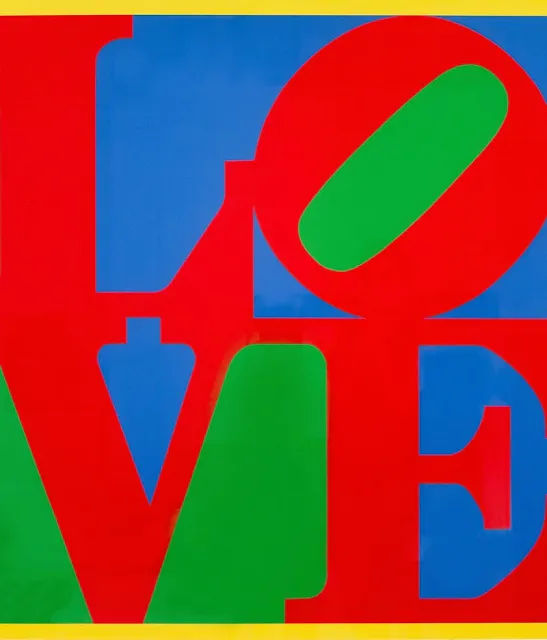Hard edge painting, also known as pittura a contrasti netti in Italian, is a distinctive style within the realm of abstract art. Characterized by abrupt and clear-cut contrasts between different areas of color, hard edge painting often employs simple geometric shapes and straight lines. Each area of color in these compositions is typically homogeneous and monochromatic, creating a visually striking and precise aesthetic. This style, emerging in the mid-20th century, offers a sharp contrast to the more fluid and dynamic approaches of abstract expressionism and action painting.
Style
Hard edge painting is closely associated with geometric abstraction, Op art, and Color Field painting. The term "hard edge" was coined by art critic Jules Langsner of the Los Angeles Times in 1959. Langsner used the term to describe the works of American painters such as John McLaughlin, Lorser Feitelson, Karl Benjamin, and Frederick Hammersley. These artists, in an effort to distinguish themselves from the burgeoning wave of abstract expressionism and action painting, opted for a style marked by flat areas of color applied with meticulous precision.
The geometric style of hard edge painting echoes the works of early 20th-century abstract artists like Kazimir Malevich, Wassily Kandinsky, Theo van Doesburg, Josef Albers, and Piet Mondrian. Unlike the figurative tendencies of Pop art, which was also prominent at the time, hard edge painting focused on non-representational forms and pure color fields. This new style found a fertile ground in the United States during the 1960s, particularly in California, which became its primary hub.
The inaugural exhibition that gathered artists of this new style was organized by Jules Langsner at the Los Angeles County Museum of Art in 1959. Titled "Four Abstract Classicists - California Hard-edge," this exhibition marked a significant moment in the recognition and promotion of hard edge painting. A subsequent notable exhibition, "California Hard-edge Painting," also curated by Langsner, took place at the Pavilion Gallery in Balboa, California, in 1964.
Influences and Techniques
Hard edge painting drew inspiration from the precision and clarity of earlier abstract movements. Artists like Kazimir Malevich and Piet Mondrian had already explored the power of geometric forms and pure color in their works. However, hard edge painters took these concepts further by emphasizing even sharper lines and more abrupt color transitions.
Techniques in hard edge painting often involved the use of masking tape to achieve the clean, precise edges characteristic of the style. Artists would carefully plan their compositions, often using mathematical ratios and geometric principles to guide their designs. This meticulous approach stood in stark contrast to the spontaneous and gestural methods of abstract expressionists like Jackson Pollock and Willem de Kooning.
Prominent Artists
Several artists are closely associated with hard edge painting, each contributing unique perspectives and innovations to the style. Among them are:
Josef Albers: Known for his series "Homage to the Square," Albers explored the interactions of color through nested squares, emphasizing the psychological effects of color relationships.
Max Bill: A Swiss artist and architect, Bill's works often featured precise geometric forms and a harmonious balance of colors.
Robert Indiana: Best known for his "LOVE" sculptures, Indiana's hard edge paintings often incorporated bold, typographic elements.
Ellsworth Kelly: Kelly's large, colorful canvases emphasized simplicity and clarity, with sharp edges and vibrant hues.
Agnes Martin: Although often associated with minimalist art, Martin's grid-based paintings exhibit the precise, clean lines characteristic of hard edge painting.
Kenneth Noland: A leading figure in Color Field painting, Noland's works frequently featured concentric circles and chevrons, rendered in bright, unmodulated colors.
Ad Reinhardt: Known for his black paintings, Reinhardt's work pushed the boundaries of color and perception, embodying the principles of hard edge painting in a minimalist context.
Bridget Riley: A key figure in the Op art movement, Riley's works often employed optical illusions, using precise lines and contrasting colors to create dynamic visual effects.
Frank Stella: Stella's early works, such as his "Black Paintings," utilized simple geometric shapes and sharp lines, laying the groundwork for his later explorations in three-dimensional forms.
Victor Vasarely: Often considered the grandfather of Op art, Vasarely's work is characterized by intricate geometric patterns and bold color contrasts.
Carmen Herrera: A Cuban-American artist, Herrera's works feature crisp, hard edges and vibrant color fields, achieving a sense of dynamic balance and order.
Callisto Giovanni: Although less widely known, Giovanni's contributions to hard edge painting are notable for their precise execution and innovative use of color.
Social and Cultural Impact
Hard edge painting emerged during a period of significant cultural and social change. The 1960s saw the rise of various movements advocating for civil rights, gender equality, and peace, all of which influenced the art world. Hard edge painting, with its emphasis on clarity and order, can be seen as a response to the chaotic and often tumultuous social landscape of the time.
The precise, clean lines of hard edge painting also reflected broader technological advancements. As society became increasingly influenced by modernist architecture, industrial design, and new technologies, the aesthetic principles of hard edge painting resonated with contemporary sensibilities. The movement's focus on pure color and form mirrored the sleek, streamlined designs that characterized mid-century modernism.
Conclusion
Hard edge painting represents a significant chapter in the history of abstract art. Its emphasis on sharp contrasts, geometric precision, and monochromatic color fields offers a unique visual experience that continues to influence contemporary art. From its origins in California to its recognition on the global stage, hard edge painting has carved out a distinct niche in the art world.
As we look to the future, the legacy of hard edge painting endures, inspiring new generations of artists to explore the boundaries of color, form, and perception. The style's commitment to clarity and precision serves as a testament to the enduring power of simplicity in an ever-evolving artistic landscape.





.jpg)







No comments:
Post a Comment